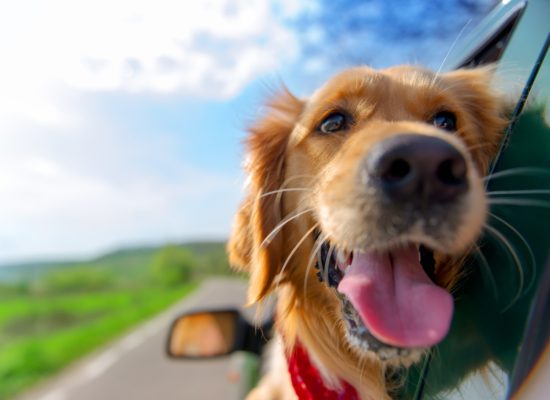Whether by plane or car there are some important things to consider when traveling with our pets.
No matter where or how you are traveling make sure your pet is microchipped (remember to register!) and has proper identification with a collar and tag that includes your name and phone number.
Plane Travel:
If you must travel on a plane with your pet, then having them with you in the cabin of the plane or under your seat would be ideal, rather than under the plane with the baggage. Most airlines allow cats and small dogs on the plane for an additional fee. If your pet has to travel under the plane it might be best for them to stay at home or find other arrangements. Some planes do not have climate controlled baggage areas which means that the temperature can significantly vary depending on the time of day or time of the year. It is important to find out what accommodations they offer for your pet on a plane, and if the area is climate controlled.
If you have to fly with your pet then it is generally required by almost all airlines that your pet have an exam and health certificate filled out within 10 days of travel. This will require you to make an appointment with your veterinarian and alert them that you will need a health certificate for your pet to fly. This exam will help evaluate if your pet is healthy enough to fly, make sure they are up to date on vaccines, and give an opportunity to discuss proper carriers and other aspects of pet friendly air travel.
Car Trips:
Traveling in the car with your pet (unless they are very accustomed to car travel) should involve more than loading them in and heading off.
Many cats and dogs may become anxious or can become car/motion sick during travel. You should consider trying them on short drives first to see how they do. If you travel across state lines with a pet, technically you do need a health certificate. Although this is not usually an issue, it is a good idea to at least travel with proof of rabies vaccination and make sure they have proper identification.
Seat belts aren’t just for people! Dogs and cats need to be restrained as well. For many dogs and cats this means a well-ventilated travel carrier. Make sure to place the carrier in a way that it will not roll over or shift in the event of a crash or short stop.
If your dog is large or you don’t want to crate them, a dog specific car harness attached to a seat belt is ideal.
Having your pet lose in a car during an accident can result in life threatening injuries from high velocity impacts or loose objects falling on them. Be sure to check your local and state requirements on pet restraint in a vehicle.
Motion sickness/Anxiety:
With any travel many cats and dogs will become anxious or may get car/motion sickness. It would be worth talking to your veterinarian about ways to prevent this should it occur. Many animals can be prescribed anti-motion sickness/nausea medications. In addition, not feeding the morning of a car/plane ride can also be helpful, but make sure to always provide fresh water.
If your pet is anxious during a trip they may vocalize, behave erratically, urinate or defecate inappropriately and be more likely to become nauseous or vomit. An anti-anxiety medication can be provided at the direction of your veterinarian to help prevent this. If your veterinarian prescribes a medication, don’t wait until the morning of your trip to try them for the first time as pets can have unexpected reactions to any new medication. The first dose of a medication is best tried in the safety of your own home in a controlled environment.
Traveling with pets can be a stressful but necessary part of the holiday season. By following these few easy tips, planning ahead and having a conversation with your veterinarian, you can make any trip safer and less stressful for you and your pets.
Author: Dr. Tom Taney

